ICCA Mid-Atlantic Quarterfinal at Binghamton University
On Saturday, February 5, Binghamton University played host to to an International Championship of Collegiate A Cappella (ICCA) Mid-Atlantic quarterfinal. The event took place in Watters Theater, a nicely-sized and comfortable venue with plenty of light. One of the most interesting stories heading into this show was that a number of the competitors have advanced to semifinals in recent years--only two could move on from this show, so the competition was sure to be steep. The show was hosted by two home groups--the energetic and engaging Binghamton Crosbys and smooth-sounding Kaskeset. A special thanks goes out to Will Browar for handling ACB photography for the night.

The show kicked off with first-time ICCA competitors The Dynamics from Muhlenberg College. This co-ed group arrived on stage with the girls wearing black dresses and the guys wearing all black attire with different color ties--a nice mix of uniformity while still allowing individual members to assert their identities.The group started its set with “Happier” by Guster. This was a very good song choice that allowed the group to showcase its vocal talents. However, I thought the solos were a little bit on the soft side and I couldn’t tell if it was the result of a lack of projection on the group’s part, or if the sound for the event had not yet been adjusted perfectly.Volume level aside, the group members sounded in tune and executed their first song very well.
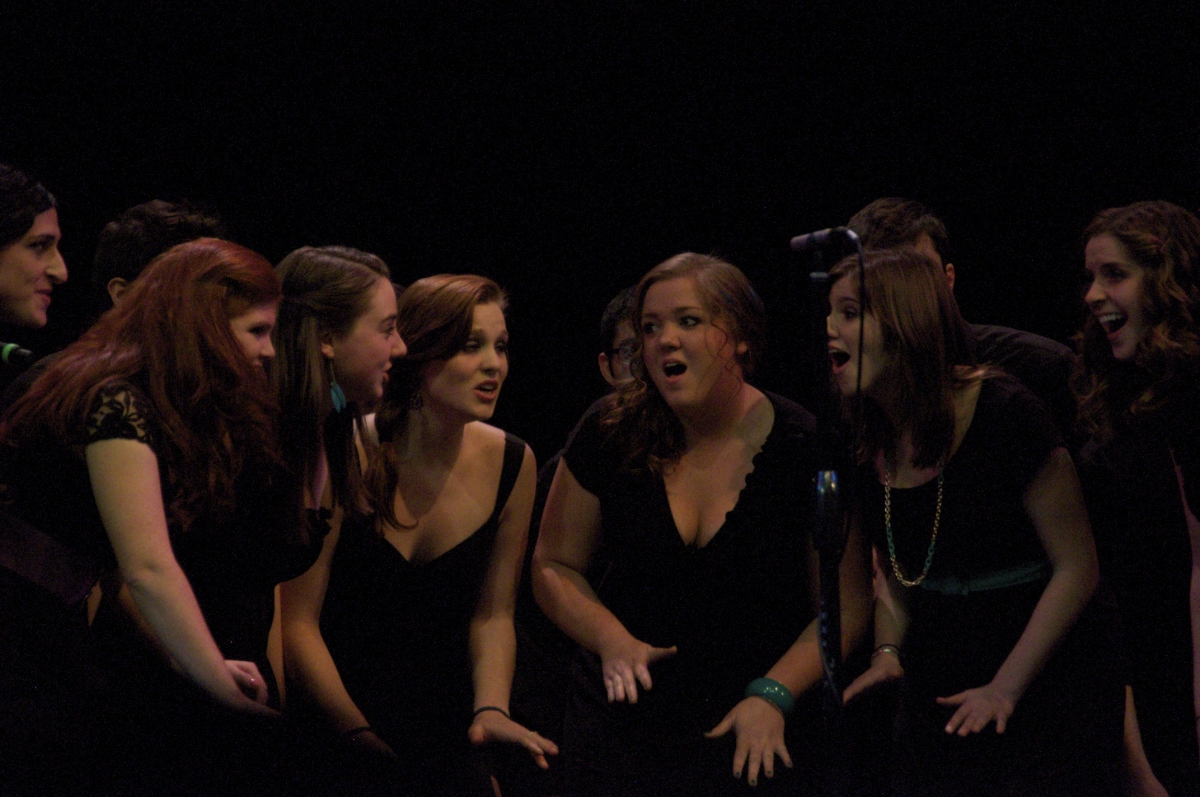
Next up, we heard “Soon We’ll Be Found” by Sia. I love songs like this because they give the soloist the opportunity to channel the meaning of the song through her emotions. In this case, the soloist took no prisoners, reaching from deep within to convey the feelings of anger and exhaustion the song refers to. The subtle sways back and forth from the rest of the group supported the ideas of uncertainty and fatigue. Nicely done.
As we approached the end of the first set, I was hoping the Dynamics would pick a more upbeat number to both offset the sullen nature of the previous piece and to leave the audience and judges energized and engaged. They chose My Chemical Romance’s “Welcome to the Black Parade,” which proved itself to be a microcosm of the group’s set, starting out slowly and speeding up toward the end. I thought it was a very good choice, and between the duet, vocal percussion, full backing vocals, this song came together nicely for the group. All in all, a nice set for the first-time competitors and good start to the evening.
Next to arrive on stage was Binghamton University’s ‘80s a cappella group, Rhythm Method. The girls and guys came out sporting mixture of red and black apparel, which made for a classy look.The group’s first song was Billy Idol’s “White Wedding.” The solo was a bit soft during the verses but really picked up during the chorus, where the soloist was able hit the high parts really well and keep complete control of his voice, which was impressive.
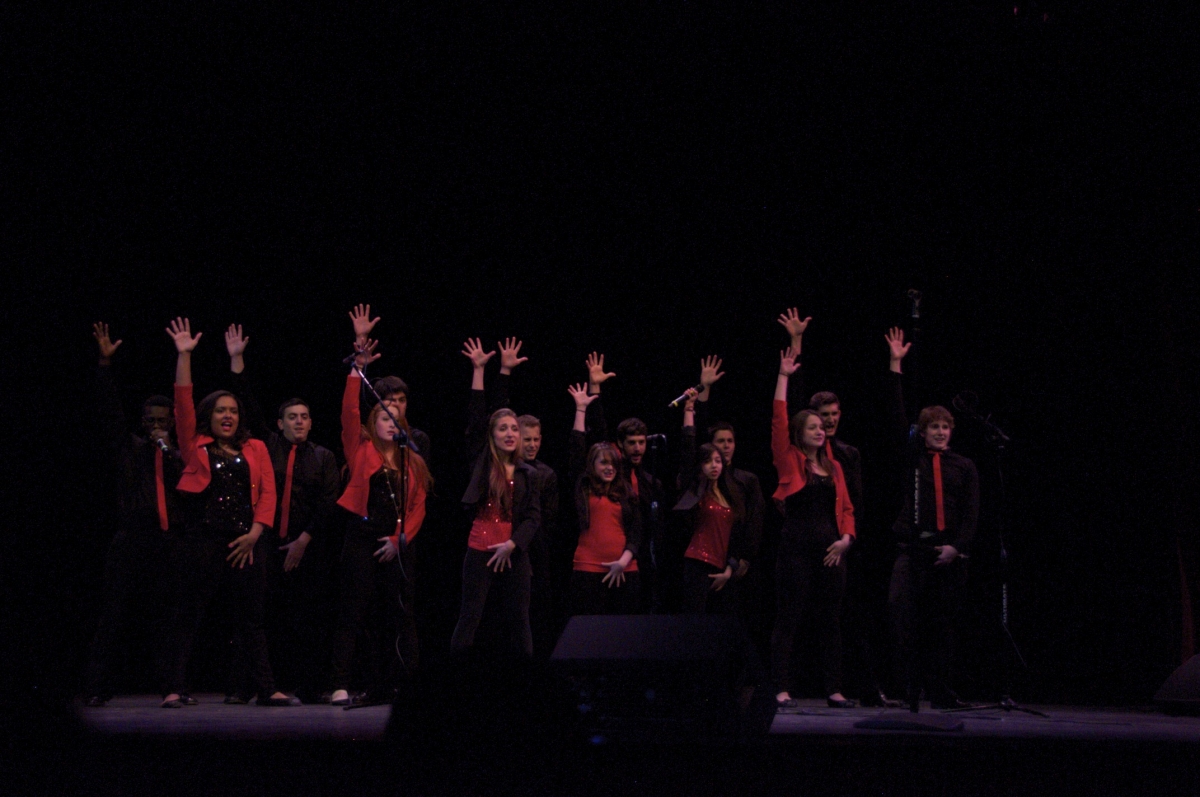
For their second song, Rhythm Method chose the much slower (and arguably more powerful) “True Colors” by Cyndi Lauper. The duet in this piece is what really worked for me--clear and in key. Group members started out in two distinct groups and, as the song progressed, came together into one formation, representing unconditional love.
The group completed their set with a Michael Jackson medley that included segments from “Bad” and “Smooth Criminal” – I like this transition back to a faster-paced number. On top of that, the choreography was entertaining, as the group interwove a number of signature moves, including the Thriller dance, and concluded with the quintessential MJ hand-up, head-down , crotch-grab pose. This was another solid performance to close out a very good set.
The next group to take the stage was Groovestand from Syracuse University. The group consisted of an almost even split of guys and girls, and members were dressed in varying articles of black and blue color. First song up was India.Arie’s “Therapy.” While there were several good parts to this performance, including a solid solo and rich-sounding backing vocals, the choreography stood out the most to me. The group utilized several side-steps, swaying movements, marches, stomps, and spins. The song lyrics would have you believe the choreography should be a little more subdued, but given the tempo of the song, I think the group had just the right amount of unique and fun moves to result in a stellar performance.
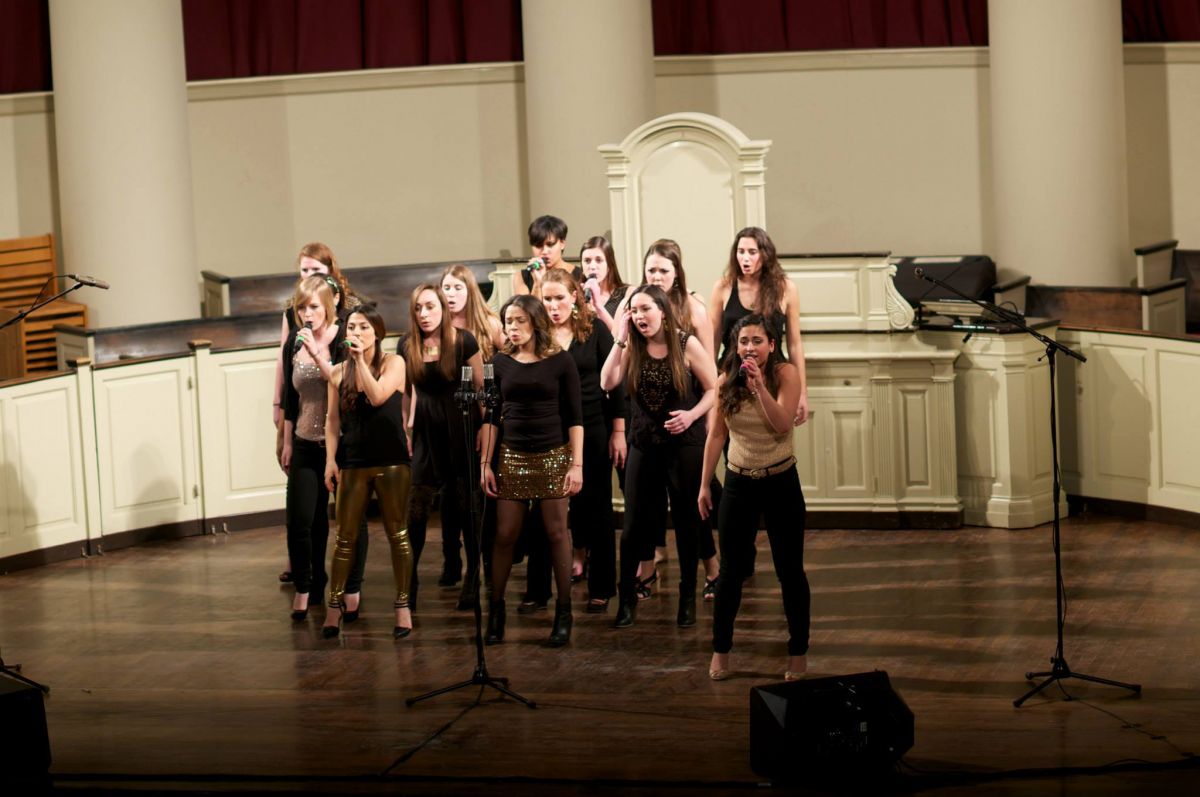
The group continued its relationship-themed set with Jordin Sparks’ “No Air.” I like this song for two reasons. First, the song's meaning was easy for audience members to relate to, which helps bring people into the song. Second, it enabled Groovestand to take full advantage of its co-ed-ness, with the vocal range to perform both the male and female parts, which they did in spades. In addition, the backing vocals were full and powerful, especially toward the end of the song when it looked like everyone was really getting passionate about the performance. Very well done.
I liked the way in which Groovestand transitioned to its third song--the group started with a slow rendition of “Turn the Beat Around” by Gloria Estefan, and quickly shifted to Usher’s “More.” As you might expect from an Usher song, the choreography was pretty cool, too. Group members started by marching in place, then began to smoothly step from side to side while synchronously alternating shoulder shrugs. Transition back to “Turn the Beat Around,” now with the entire group salsa dancing. Perhaps the most entertaining bit directly followed, when group members formed a “V,” while another member stood behind them and mimicked a propeller blade while the rest sang the lyrics “Turn the Beat Around.” Overall, great performance by the SU group.
On to another Syracuse group--Main Squeeze. The women wore black dresses, each member with a different color stockings. I thought it was cool.
Their first song was “Cosmic Love” by Florence and the Machine. Interesting selection that incorporated love, despair, and confusion. The solo itself didn’t convey the raw emotion I expected from a song like this, falling a little flat at times. I really liked that the members formed a group on stage, facing the audience and mimicked a heart beat with their bodies--first the middle third of the group convulsing, then the left third, and finally the right third, all while using heartbeat syllables like “bum, bum, bum.”
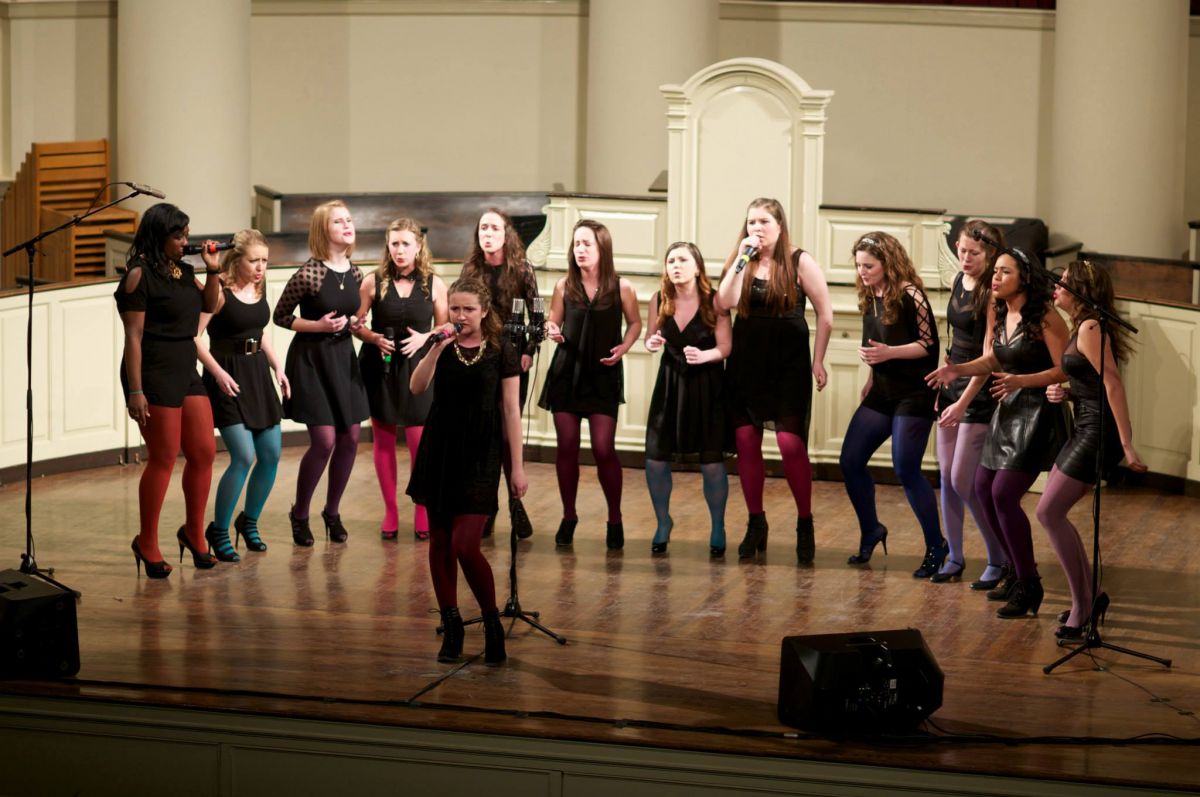
By the end of the first song, all members were lined up in front across the stage, which they used to transition into their second song, “Settle Down” by Kimbra. Good solo here, and again, some cool choreography to boot, with members circling the soloist on stage during the song. The piece concluded with the soloist approaching the edge of the stage, looking out at the audience. I was expecting a dramatic climax to hit at any moment--only for the song to simply end.
The group’s final number was VV Brown’s “Shark in the Water.” The soloist was extremely powerful as were the backing vocals. The group included a combination of sways and hand movements, including pointing at the audience at times. What’s interesting about the group’s set is that each of the songs had a deep focus on relationships--I’m not sure if the group planned for that, but I think a group “theme” in song selection is a unique way to differentiate itself, which, in this case, seemed to work well.
The last group to hit the stage before intermission was Syracuse University Orange Appeal. These guys sported the classy, yet casual jean, button-up shirt, and different-colored tie look. The group began its set with Bon Iver’s “Beth / Rest.” Although I normally prefer that groups lead off with a faster number and save the slow songs for the middle of the set, the power with which this was delivered was enough to grab the attention of any audience. The vocals were right on key, and the lack of any choreography throughout the song forced the audience to focus strictly on the collective sound. I was very impressed.

Next, the group sang “Sir Duke” by Stevie Wonder. I have to say, this song represented everything I love about competitive a cappella--a great mixture of strong VP, fun choreography with members side-stepping and pretending to play instruments, and a strong solo. On top of that, the group further entertained the audience with a cool effect on stage--while the soloist sang the line “you can feel it all…,” the percussionist stopped and extended the word “over” in a higher-pitched voice as if he “threw” it into the air--group members pointing upward at it--to be “caught” by the percussionist, who then resumed the song.
For their last song, the guys sang Coldplay’s “Paradise.” I thought this was a very good song choice, especially for an all-male group. The song itself has a good range, and the tempo enables groups to do a lot in the way of choreography. In Orange Appeal’s case, we saw a variety of movements, including a front-step, side-step, back-step weaving pattern and, at one point, group members pulled out their cell phones and waved them in the air. All in all, a very good set.
The next group up was The Haverford College Outskirts. This all-female group wore classic black skirts and white tops. The group started its set with Ingrid Michaelson’s “The Chain.” The women formed two lines toward the back of the stage and as the song progressed, the soloist emerged, then the rest of the group rounded out to form an arc, all before a word was sung. Very cool. The few- to many-, back to few-part harmonies throughout this song came together nicely. The amount of choreography was just about right for the song, and the complete lack of movement by the soloist really helped hone in on the song’s story of a girl waiting for her lover to come back.
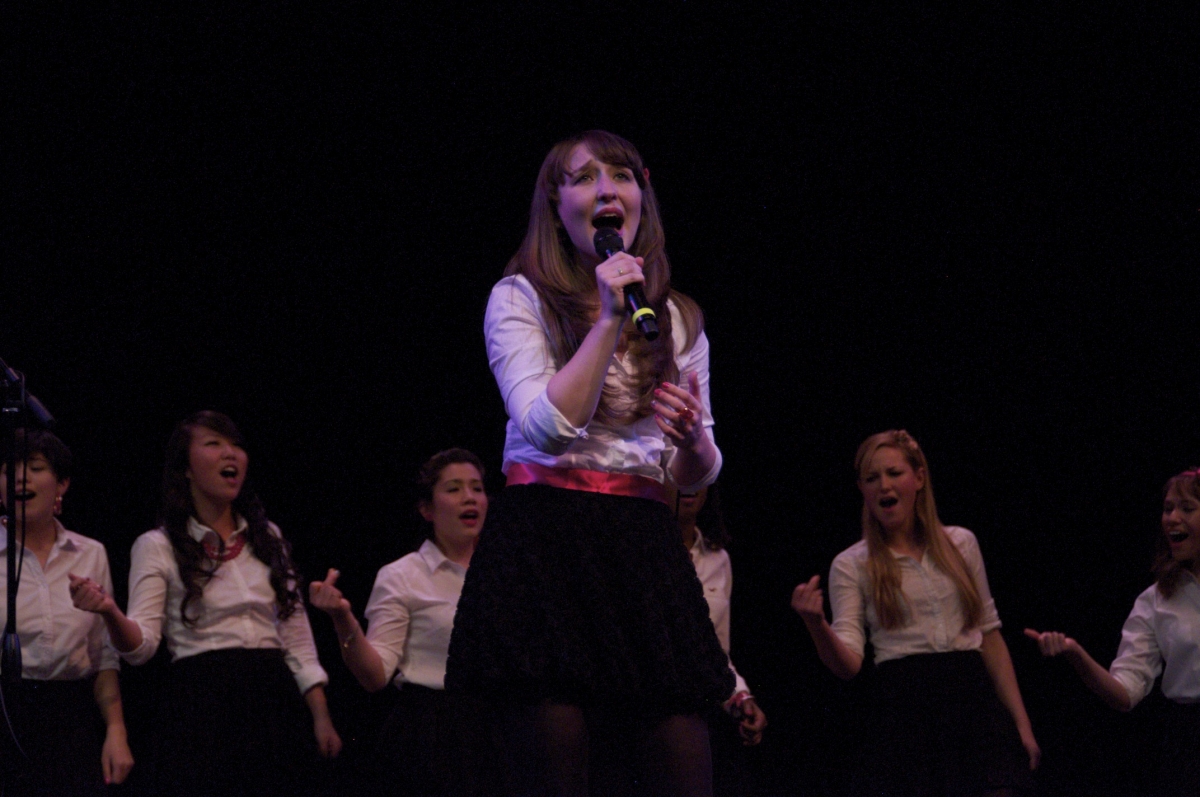
To further assert themselves as part of a group to be reckoned with, The Outskirts followed with “Many Moons” by Janelle Monáe. This was an interesting selection primarily because it has so many different (and cool) parts between the verses, refrain, chorus, a cybernetic chantdown, and a closing lullaby. And trust me, the group capitalized on all of them. Group members started by forming two groups on stage, putting their heads down, raising them to begin what would be robot dance into a crouch sway, back into the robot dance. Intriguing start to the choreography. Vocally, I thought the first soloist sounded on key and had pretty good control of her range. The second soloist, who performed the chant piece of the song, was not quite as melodic, but I suppose that’s to be expected in a chant. What made this piece stand out even more was the group’s decision to have the vocal percussionist emerge from the rest of the group following the chant and give the audience a full-out beatbox performance, which was really neat--particularly coming from an all-female group. Nice work.
The group rounded out its set with “Who’s Loving You” by The Jackson 5. Absolutely killer solo here. From her facial expressions, arm movements and fist crunches alone, you could see how passionate she was about conveying this song’s meaning. Add in the vocals, and there was nothing left to question. The range was impressive, and she hit all of the highs and lows while seemingly immersed in the song and not caring what the audience thought, but rather singing for herself. The backing vocals were rich and strong too. Just the right amount of choreography here. All in all, this song was a great way for the ladies to finish up their set.
Next up were The Deaftones from Westminster Choir College. This group of 21 (yes, 21) members dressed in black, with the guys wearing green suspenders and ladies wearing green belts. The group positioned itself with every member’s back facing the audience and began with a short intro of Iyaz’s “Replay” which quickly turned into “Africa” by Toto. I’m not exactly sure what the connection between the two songs was, but I was willing to go with the flow, since I’ve seen crazier things turn out really well. The solo and subsequent duet sounded very good, but on at least two occasions, one of the male members of the group would come to the front of the stage, and at the same time sing the chorus to “Replay,” which, frankly, muffled what was a fine duet. I thought this would have been a much stronger performance had that been omitted.

I have to say, the Deaftones turned it completely around with their second song, “Skyscraper” by Demi Lovato. This was the type of solo that just pierced you. I mean, it looked like the girl didn’t open her eyes at all during the performance and you could tell the audience was hooked. This song has a wide range of parts—highs, lows, fast, and slow, and the soloist could handle it all with complete control. While the soloist was belting out fantastic notes, the rest of the group members produced loud and rich sounds themselves that complemented the solo and enhanced the overall performance. This was undoubtedly one of the best vocal performances of the night.
For their final number, the group chose to sing “Tubthumping” by Chumbawamba, an upbeat song of which I am a huge fan. I loved the energy, too. The group started out in the huddle formation with which they ended their previous song and went right into an all-out dance party with stomps and hand movements--I was really getting into it. Then, the group formed two lines with the guys in front and women in back and alternated crouching down and throwing hands in the air (this would repeat throughout the song). The group was able to stay in tune throughout all of the movements, which, itself, was quite impressive. The various solos and duets throughout sounded pretty good, but the heart of this song, in my opinion, was in the collective performance, and group did quite well here. The song concluded, as you might expect, with the ladies singing “pissing the night away” and one of them even passing out in front of the group (intentionally). All in all, a solid set for The Deaftones.
On to the second-to-last competing group of the night, Casual Harmony from Rutgers University. The all-male group had on its traditional jeans and different-colored-button-up shirt getup. For the group’s first song of the night they chose “Give a Little More” by Maroon 5. I thought the tempo and melody of this song made it a great choice to lead off with. The guys leveraged everything they could with it--they started with some smooth choreography which included the entire group seamlessly leaning to one side and then returning to a full upright position. Shortly after, the group threw in a slow pelvic thrust that originated from a crouched position, which really got the (female) audience going. The soloist had a unique sound and a great aptitude for hitting the high notes, which lent itself well to this song (and any song Adam Levine sings, for that matter). In addition, the three-part harmonies throughout the song made for a clear and vibrant sound, and the theatric hand movements, and shuffles in the background made this a really cool showing. The VP also caught my attention--nicely executed. The song ended by Casual Harmony coming together to form an “M” on stage.
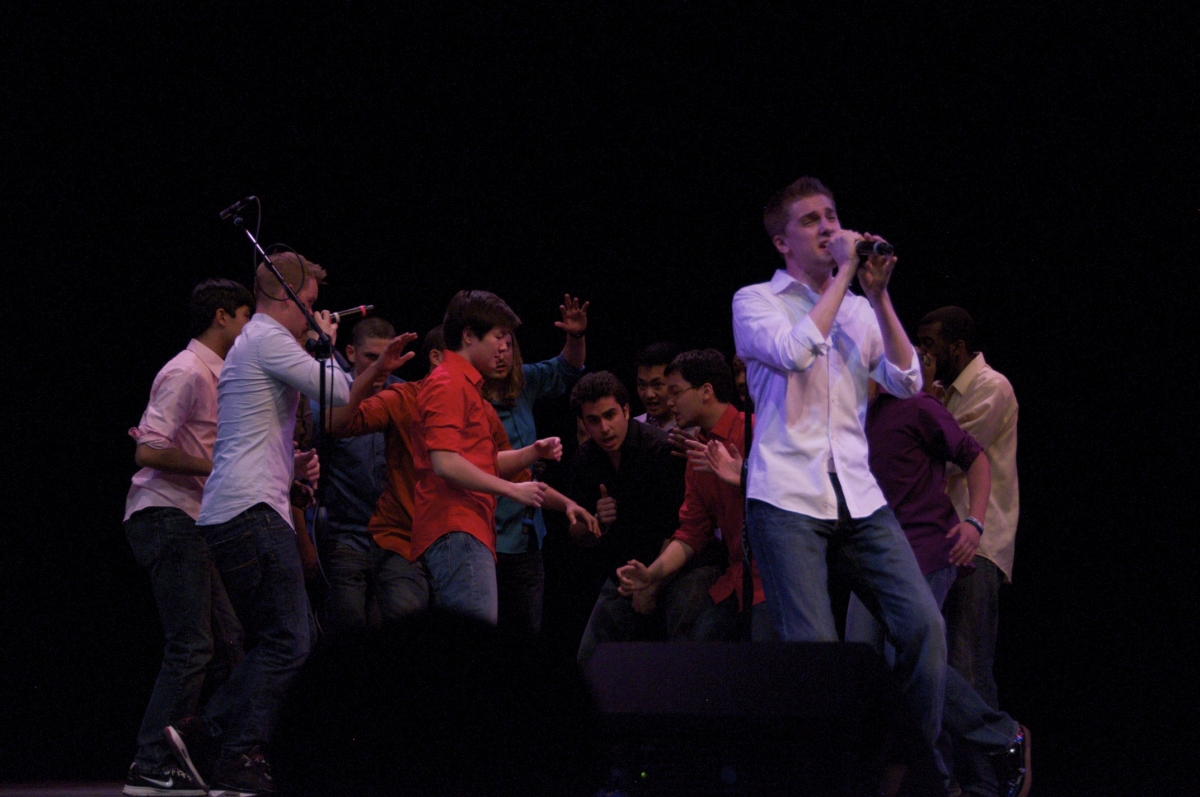
Next for Casual Harmony was “Say” by One Republic. At the start of the song the group was still in its “M” position and even after the soloist began, swayed to the left and right until it slowly broke into two separate groups on stage, which I thought was a cool visual. The soloist sang this song with a great falsetto and strong conviction--a powerful combination that really worked for the guys. The visual presentation for this one was really unique, including an imaginative move in which group members crouched and swung their bodies in a circular motion. The song ended with the group members in a tight huddle facing one another while the soloist stood a few feet in front, facing the audience with his head down. The audience applauded for much longer than the three seconds they were instructed to at the beginning of the show.
The group finished its set with “Valerie,” originally by The Zutons. The group just looked like they were having a great time with this song. The soloist was working the stage, pacing from side to side, crouching down and singing to specific members in the audience (who loved it). This goes to show you that in competitive a cappella, it’s about more than just the voice. Stage presence and likability play a large role. I’m not saying that this soloist's vocals were lacking in the voice area, but he probably could have gotten away with a less-than-perfect solo. Fortunately, he and the rest of the group didn’t need to worry about that. While the soloist was swooning the audience, the rest of the group was busy filling the theatre with their rich backing vocals and entertaining choreography, which included snapping, side-stepping, and pretending to row a boat and play instruments. A nice little amalgamation of elements that packed a punch. Great work on the part of the group.
The last group of the night to take stage was University of Rochester Vocal Point. This all-female group came out wearing simple, yet stylish pink dresses. Vocal Point started its set in a “V” formation with the soloist at the point (the vocal point, if you will *rimshot*). They chose to sing Queen’s “Don’t Stop Me.” I thought this was a great upbeat number with which to begin a set, as it allowed for some cool choreography while demanding a strong solo. Speaking of which, as the song’s tempo picked up, the “V” widened and became two lines of group members swaying back and forth, which turned into alternating shoulder shrugs, which turned into a plethora of other motions that, as the song suggests, looked like the group was “having a good time.” I thought the soloist was good vocally, hitting a lot of the right notes, and only falling flat a couple times, but I would have preferred that she not move across stage so much, only because the rest of the group had enough choreography going on. Not a bad start, though.

For its second song, the group sang “Dog Days Are Over” by Florence and the Machine. I liked the song selection a lot. The solo was very good for the most part, but she didn't quite hit some of the higher notes. The backing vocals sounded spot on, offering the right volume level and fullness, and the incorporation of clapping throughout the song really jazzed it up and energized the audience (who, after eight other groups, needed that nudge). The song concluded with the women shifting their heads left and right before stopping abruptly.
The final song of the set was “Cathedral” by Crosby, Stills, Nash, and Young. The song started out very slow, with only four members singing in front, while the remaining seven stood in a line behind with their heads down. As the song progressed, the back row joined the front and began to sway back and forth until the song started to pick up speed and the group formed a quasi-“W” and began to sing louder and more pronounced. The fluctuation in pace and choreography kept me on the edge of my seat in anticipation of the next move. Aside from the visuals, the four-part harmony was right on key, both in the beginning and after the song picked up speed, and the rest of the group’s vocals complemented them nicely. What really made this an exceptional end to the set was at the conclusion of the song when everyone in the group formed a semi-circle toward the audience, flattened out the circle, and collectively sang the last verse. Really good stuff.
All in all, this was one of the best ICCA quarterfinals I've ever attended and therefore one of the most difficult to critique. Making my picks for the winners was not easy, and I'd like to congratulate all of the groups again on their extraordinary performances.
Mike Scalise's Picks for the Night
Overall Placement:
1. Casual Harmony
2. Groovestand
3. Orange Appeal
ICCA Official Results
Overall Placement:
1. Casual Harmony
2. Groovestand
3. Main Squeeze
Outstanding Vocal Percussion: Casual Harmony for the entire set
Outstanding Choreography: Groovestand
Outstanding Soloist: The Deaftones for "Skyscraper"
Outstanding Arrangement: Main Squeeze for "Settle Down"